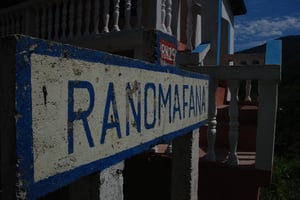$10.00 - On Sale
SCROLL TO THE BOTTOM OF THE PAGE TO BUY!
Notes for Ranomafana Rhythms Vol. 1:
All of the funds for this project were obtained through donations, and all visual and audio work were done for free, meaning that all the profits from these CD's will be going directly to the musicians featured on the project. Since there are three groups on the CD, the proceeds will be split 3 ways, with a portion of sales in the United States being saved to fund future pressings of the project. Funds will be handled through The Institute for the Conservation of Tropical Environments, or ICTE, a conservation organization that focuses on issues in Madagascar (http://icte.bio.sunysb.edu/). This is a unique opportunity to buy music from another country with none of the gross profits going to a middleman. It's an attempt to go even further than Fair Trade.
The music in this collection comes from the area surrounding Ranomafana National Park in Eastern Madagascar. The park boasts a wealth of flora and fauna unique to the subcontinent, including 12 species of lemur, and is the result of a long planning process involving the input of local communities. Scientific discovery in the park is managed by the CentreValBio research station with the help of the local chapter of the Malagasy park system, ANGAP. This project is a way to help locals make money based on their talents and unique traditions, which ideally reduces stress on the forests and improves living conditions for the people involved.
The collection begins with a series of selections from the Ambatolahy-Dimy Community Band. Ambatolahy-Dimy is a small town located half way between the park and the town of Ranomafana, and many of the amazing research guides that enable the scientific discovery in the area come from this town. The music is based around the cabousy (a small, guitar-like instrument), percussion and voices. The profits from their share of CD sales will be going to the Ambatolahy-Dimy Cultural Center, which helps fund arts and crafts work that generates funds for the community and also helps fund basic public work initiatives for the town.
The second group on the CD is a group of school children from the town of Bevohazo, located 15 km from the nearest paved road on the edge of the park. The music is joyful and buoyant, based around voices in harmony and percussion that includes bamboo shoots hit against the ground to produce a low, drum-like tone. The name of this style of folk dance music is Dombolo. The funds from their portion will be used by the village elders to improve the educational conditions in the area, which are generally poor due to their remote location and lack of funds.
The final part of the CD features a musician named Dadalira who was one hundred and one years old at the time of these recordings. He moved to the Ranomafana area in the 1940's and has played traditional folk songs since he was a young man. His music revolves around his weathered voice and a self-made instrument called a valiha or marovany, which is a box strung similar to a harp, with between 8 and 10 strings on two of its sides that are plucked to produce notes. Dadalira's music shares much in common with older American Blues, and ranges from spooky to upbeat and silly. The profits from his share will be given to him.
Special Thanks for this project go out to the village elders and residents of Ambatolahy-Dimy and Bevohazo, Dadalira, CentreValBio Staff, ICTE Staff, Narindra, Tantely, Patricia Wright, Christopher Chapple, and the ICTE Study Abroad Students of 2005 and 2007.
All Songs on this Collection Copy write Ranomafana Rhythms 2008.
Project Contact: Dylan Chapple
[email protected]

